4 Symptoms of a Rear Main Seal Leak (and Replacement Cost)
Some of the trickiest mechanical issues to pinpoint for repair, tend to be oil leaks. Dreaded rear main seal leaks in particular can send technicians on a wild goose chase and require labor-intensive, time-consuming repairs.
Arm yourself with knowledge before facing this substantial headache. Read on to learn the common symptoms of a rear main seal leak, how serious it is, and how much it’s going to cost for replacement.
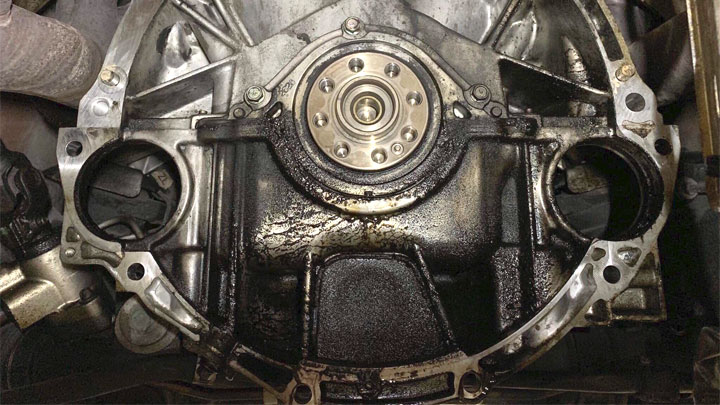
Read Also: 6 Symptoms of an Oil Pan Gasket Leak
Signs of a Leaking Rear Main Seal
A rear main seal leak can be identified in a number of ways, some of which prove far more evident than others. Being mindful of such symptoms will assist you in coming to an early diagnosis, thereby expediting the repair process.
The following are the most common signs of a rear main seal leak.
#1 – Puddling of Oil in Driveway

Rear main seal leaks tend to worsen when an engine has warmed to its standard operating procedure. For this reason, a leaking rear main seal is often most evident in the minutes to hours after a vehicle has been parked for the day.
This, in turn, leads to the puddling of oil beneath a vehicle’s engine, leaving behind ample evidence of such issues.
Therefore, the sudden appearance of an oil stain within the driveway is cause for concern and should be carefully studied to determine its point of origin. It is also possible for this pooling of oil to worsen with time.
#2 – Need For Frequent Top-Offs
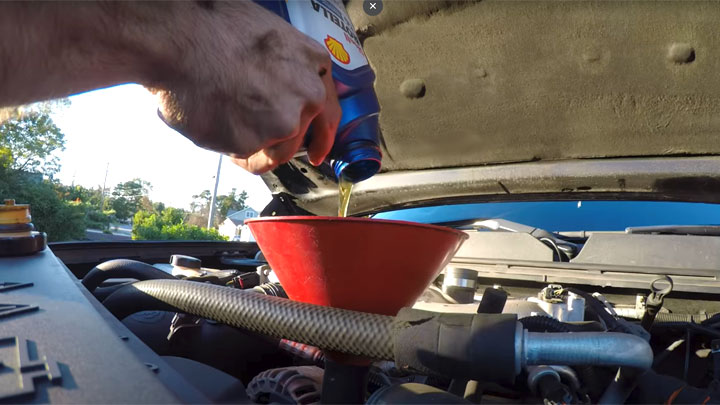
Rear main seal leaks are known for their tendency to leak an excessive amount of oil in short order. In severe cases, a compromised rear main seal can leak as much as a quart of oil in a week’s time.
This rapid loss of oil will necessitate frequent top-offs, to avoid an engine’s oil from dropping to dangerously low levels.
If a weekly inspection of our vehicle’s engine reveals unanticipated oil loss, or if you suddenly find yourself adding more oil to your engine than normal, a worn rear main seal could be to blame. Therefore, additional time should be taken to assess the cause of this expedited oil usage.
See Also: Symptoms of a Valve Cover Gasket Leak
#3 – Oil Saturation of Vehicle Underbody
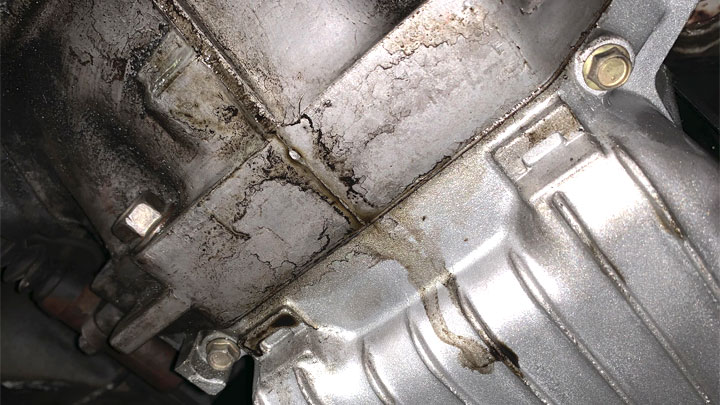
Since a leaking rear main seal tends to cause pooling of oil within an engine/transmission’s bell housing, it is not uncommon for blowback to cause extensive oil saturation of a vehicle’s underbody. As a vehicle is operated, leaking oil is swept rearward, coating all that lies behind the rear of a vehicle’s engine.
This places additional importance upon periodically inspecting your vehicle. Simply glancing beneath your vehicle will reveal such tell-tale signs of rear main seal failure, in the vast majority of cases. This allows you to plan for repair before the offending leak grows in severity.
#4 – Illumination of Oil Light

If you are driving along only to notice the sudden illumination of your vehicle’s low oil light, there are two main things that you should do.
The first of which is to pull to the nearest shoulder of the roadway and shut off your engine as soon as possible. The second task of essence is to figure out where your engine’s oil has disappeared. In a case of this nature, an engine’s rear main seal is suspect.
A severe rear main seal leak can cause rapid oil loss, especially when an engine is warmed to operating temperature, and the affected vehicle is in motion. If oil loss exceeds a particular point predetermined by a vehicle’s manufacturer, a low oil light will illuminate upon the dash.
Likewise, some vehicles will display a low oil pressure light or message in a similar manner.
What is a Rear Main Seal?
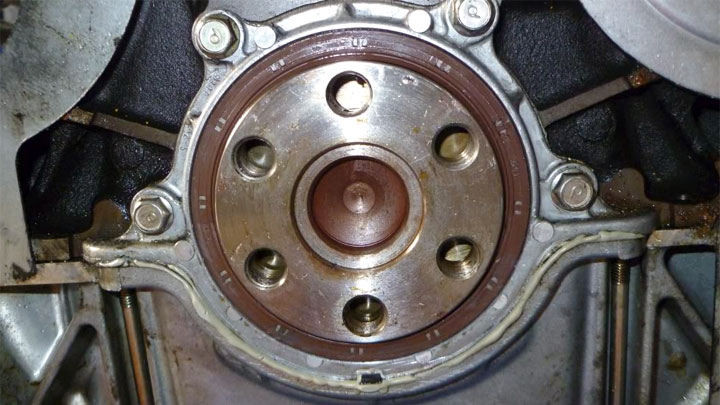
In the simplest of terms, a rear main seal is a seal used to prevent oil loss from the rear of an engine, where the engine’s crankshaft mounts to the transmission, via a flywheel or flexplate. This, in turn, gives birth to the rear main seal’s nickname as the rear crankshaft seal.
Seals of this type are typically driven into a recess within an engine’s rear cover and are generally concealed within the bell-housing of the transmission itself. In most cases, it is impossible to view an engine’s rear main seal, once it has been installed, and a vehicle has been returned to service.
Without a properly functioning rear main seal, a vehicle’s engine oil is allowed to escape outside of its normal point of retention within the crankcase. As such, a noticeable leak is presented, which can range in severity by substantial margins.
What Causes the Seal to Leak or Go Bad?
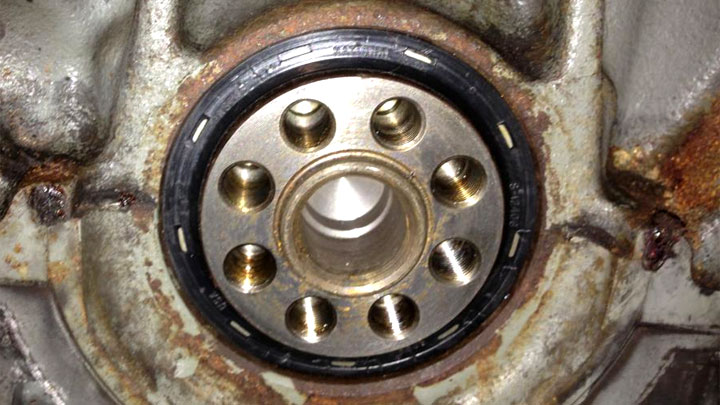
The single most prevalent cause of rear main seal leaks is simple wear and tear. Seals, though relatively hearty, are not designed to last indefinitely. Instead, it is quite normal for an engine’s seals to break down as a vehicle ages and miles accumulate. As this occurs, seepage begins to take place.
Prolonged periods of vehicle storage can also lead to higher instances of rear main seal failure. Seals of this type generally rely upon splash lubrication from an engine’s oil, in order to ward off early degradation.
When a vehicle sits idle for extended periods, this splash lubrication ceases, thereby allowing seals to dry, harden, and crack. As a result, leaks often become evident shortly following a vehicle’s return to service.
Less commonly, a rear main seal might begin to leak if an engine is low on oil. While running an engine 1-quart low on oil for a brief period of time is unlikely to cause any issue, operating an engine in this manner for extended periods can lead to seal drying and hardening.
Therefore, it is best to routinely check your vehicle’s oil level, to prevent further issues at a later date.
Is a Rear Main Seal Leak Serious?
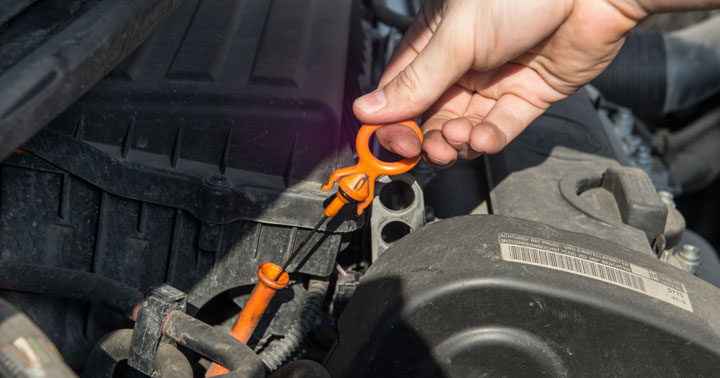
A rear main seal leak is generally regarded as being quite serious in nature, due primarily to the fact that such leaks only tend to worsen with time.
In severe cases, a rear main seal can leak to the point of creating difficulties when attempting to keep up with the resulting oil loss. Simply put, adding enough oil to maintain proper lube supply becomes troublesome.
However, this is still a far better scenario than what will likely occur should an engine become starved for oil, at the hands of a rear main seal leak. Any substantial loss of lubricating oil poses the risk of causing bearing damage, which can ultimately result in untimely engine failure.
At the very least, running an engine low in oil can, and will, cause premature internal wear. In any event, a rear main seal leak should be addressed at the first available opportunity.
While repairing a leak of this nature can get rather involved, it is still nowhere near as troublesome as being forced to replace an engine that has suffered the prolonged effects of sustained oil loss. If you are not up to the task of completing such repairs yourself (most will not be), make an appointment with a trusted service center as soon as possible.
Can a Rear Main Seal Be Replaced Without Removing the Transmission?
Conventional rear main seal replacement requires a vehicle’s transmission to be removed. This is necessary to gain access to the rear main seal itself, which is housed at the back of an engine, within the transmission’s bell housing.
Unfortunately, removing a vehicle’s transmission is no small feat, and is rather time consuming to complete.
Luckily, there are now several products on the market that claim to stop rear main seal leaks in their tracks. These products are designed to rehydrate an aging seal, thereby restoring its sealing power. Unfortunately, products of this nature are known to produce mixed results, leading some consumers to steer clear.
However, a limited number of these stop-leak products stand out above the rest, due to the overwhelmingly positive reviews that they have received. One such product is BlueDevil Rear Main Sealer, which is often cited by consumers as being a “cure-all” for rear main seal leaks.
In any event, consumers have little to lose, when giving a rear main seal stop leak product a try. After all, when the only alternative is excessive vehicle downtime and exorbitant repair costs, the use of a single-application sealant comes as a welcome alternative.
Rear Main Seal Replacement Cost
Best places to order parts? See: 19 Best Online Auto Parts Stores

When it comes to a rear main seal leak, there is no sugar-coating the fact that repairs will be quite pricey. Even more aggravating is the fact that most rear main seals are relatively inexpensive to purchase. However, the labor costs associated with such repairs are often extensive.
Of course, these labor costs are easily justified. Replacing an engine’s rear main seal is no easy task, and requires a significant investment of time.
A repair of this nature requires a vehicle’s transmission to be removed, as access to an engine’s rear main seal is not otherwise possible. Additionally, the removal of a vehicle’s transfer case is often required in the case of four-wheel drive vehicles.
The exact price of rear main seal replacement differs from one vehicle to the next and is reflective of a manufacturer’s quoted flag time for such repairs. Pricing for rear main seal replacement is also dependent upon the drive configuration of a particular vehicle.
The price of rear main seal replacement typically ranges between $650 and $1,800, though the vast majority of such repairs fall within the $800-$1,200 price range.
Will Thicker Oil Help a Rear Main Seal Leak?
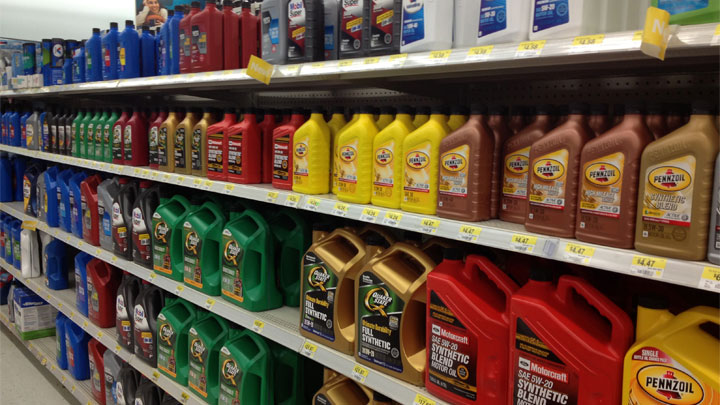
In certain cases, running engine oil of a thicker viscosity can slow rear main seal leakage. This is due to the fact that oil thins as it warms during normal engine operation.
This, in turn, allows oil to escape more easily through aging, worn, or damaged seals. This is one of the reasons that a leaking rear main seal appears to worsen when an engine is at operating temperature.
Keeping this in mind, it is reasonable to assume that oil of thicker viscosity would be less likely to seep from such a seal, even when warm. In fact, almost everyone knows of somebody who has sworn that switching from 10w30 to 10w40 has slowed their vehicle’s oil leak.
Likewise, it is even common to hear of heavier diesel motor oils, such as 15W40, being used in gasoline engines to slow a leak.
However, one must also take into consideration the possible ramifications that could arise from deviating away from their vehicle manufacturer’s specified oil viscosity. Manufacturers specify the use of a certain viscosity of oil based upon several factors, including the measure of an engine’s bearing tolerances.
Therefore, though rare, making such changes in oil selection can lead to possible oil delivery-related issues. As such, one should proceed with caution, when determining whether or not to use engine oil with a viscosity other than that recommended by their vehicle’s manufacturer.
See Also: Types of Oil (Conventional vs Synthetic Blend vs Full Synthetic)
- 5 Symptoms of an EVAP Leak (and Repair Cost) - Apr 27, 2024
- P0480 Code (Symptoms, Causes, and How to Fix) - Apr 19, 2024
- Car Temperature Gauge Stopped Working? (Here’s Why) - Apr 15, 2024
